|
Two birds with the one stone
On the championing by Christian de Boeck of the "forgeries" (refer qualification below) of Alex Grey:
Defining FORGERY the qualification:
According to the online Nationmaster, a forgery is a work knowingly passed off as a work by another.
However, the term forgery also applies to works created by someone which appear to be like those created by another even if they are not passed off as the work of another:
The Horton Pollock TV documentary definition:
New York Times online article on the Horton Pollock: http://www.nytimes.com/2006/11/09/arts/design/09poll.html
Screened as "Who The #$&% Is Jackson Pollock?" on ABC tv Australia 3:00 PM, Sunday, 16/11/2008 (url: http://www.abc.net.au/tv/guide/abc2/200811/programs/ZY9536A001D9112008T203000.htm)
One of the interviewees was a convicted British forger. He now legally sells forgeries in the manner of the works of artists such as Picasso. The art of any artist is © copyright of the artist and remains © of the artist's estate for a period of 75 years after the artist's death (which is dependant on each individual country's legal definitions). The British forger who legally forges "Picasso" amongst other artists, would be in breech of © if he were to copy outright a proven Picasso. The nature of his forgery is that his paintings can be mistaken for a painting done by Picasso. The legality of such forgery is predicated on the works being signed in the forger's own name and not in the name of the artist's work being so forged. These works are therefore legal fakes because they do not make any claim to being the art of the artist whose work is being emulated/forged, even though they look just like the work that artist produced; and they do not breech copyright because they are not outright copies of known works by that artist.
|

|
|
[-Art and Unoriginality-]
De Boeck in the late 1990s established a fan–website for Fantastic Art and Surrealism, which, hosted by Tripod, has disappeared. However, a page in which he described his mission statement survives on the internet on a site he designed for the "Society for Art of the Imagination". His mission statement to establish a "Fantastic Art Centre" with himself as self–appointed head has somehow made it onto the Wikipedia. (Refer screenshot below)
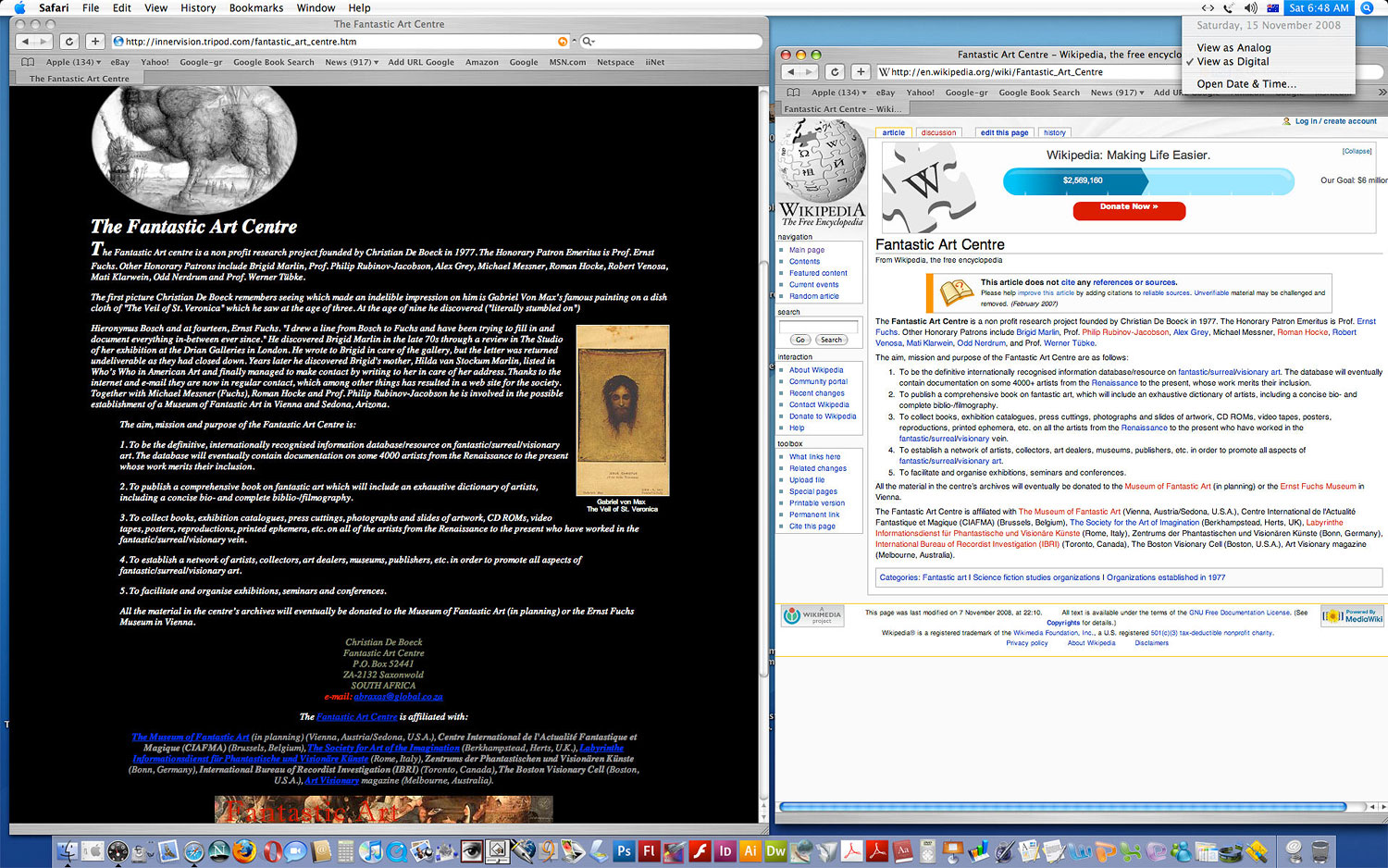
De Boeck's mission statement included "Honorary Patrons". These patrons were Ernst Fuchs, Alex Grey, and a few others.
De Boeck discredited himself in 1999-2000 in the form of vitriolic criticisms levelled against Australian–German artist Wolfgang Grasse. The criticisms were made because flattering comparisons were made between the Christian–inspired art of Ernst Fuchs with the equally Christian–inspired art of Wolfgang Grasse by another fan (of "visionary" art), Damian Michaels. De Boeck's unfamiliarity with the Babylonian/Persian–derived elements which feature in Fuchs' art meant for him that Fuchs' art was without precedent. De Boeck's familiarity with the German–Flemish/Dutch models behind the motifs that appear in the art of Grasse, meant for him that Grasse was derivative. He derided Grasse, claiming him to be a "pasticheur." [MORE] The use by Fuchs of elements derived from Jan van Eyck did not diminish Fuchs in the opinion of de Boeck, but when elements of van Eyck appear in works by Grasse, they merely confirmed for him the derivative nature of the art of Grasse.
|
|
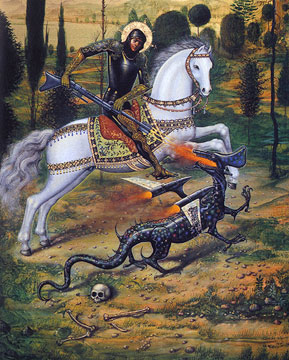 Grasse armed his mediaeval motifs with 20th century armaments.
Grasse armed his mediaeval motifs with 20th century armaments.
Art by Wolfgang Grasse
Above: Saint George and the Atomic Dragon,
Wolfgang Grasse, acrylic and gold, 1979 (detail).
P. 52, LIFE & DEATH the metaphysical art of Wolfgang Grasse.
|
As an avowed promoter of original masters and not pasticheurs, one would expect de Boeck to champion only original masters.
De Boeck's great problem: Alex Grey
Alex Grey has become a celebrity. From junkies, US popular music bands, to religious kooks, his art is celebrated as a window into the "soul" of the cosmos. One cannot but wonder why. His works are (though sometime–modified) forgeries of the work of Pavel Tchelitchev. Sometimes these forgeries by Grey include elements taken from works by another artist (for example, elements from the work of Ernst Fuchs).
| Pavel Tchelitchev's works, as in the example, right, form the basis of the works created by Alex Grey.
Tchelitchev attempted to illustrate the "energy" coursing through the body, that divides the living from the dead. He attempts via visual means to elucidate a visual definition of being alive. It is an attempt to work out the age–old question of what it is that makes us alive; whether there is a soul, or "energy" that might be soul (ψυχή psyche) which can define us. His works show the nervous system lighting with the impulses of electric energy coursing through it as the brain sends commands to various parts of the body.
One of his early works, Cache cache, exerted an influence even over my own art .
Pavel Tchelitchev died in 1957, 4 years after the birth of Grey.
|
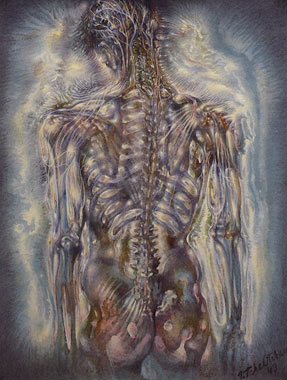 Fig. 1 The Golden Leaf, Pavel Feodorovitch Tchelitchev, gouache on paper, c. 1943. Pl. 62, Lincoln Kirstein, Tchelitchev. NJ. Crawford, New York
Fig. 1 The Golden Leaf, Pavel Feodorovitch Tchelitchev, gouache on paper, c. 1943. Pl. 62, Lincoln Kirstein, Tchelitchev. NJ. Crawford, New York
|
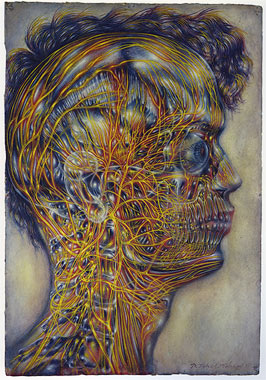 Fig. 2 God of Rain, Pavel Feodorovitch Tchelitchev, gouache on paper, c. 1947. Pl. 64, Lincoln Kirstein, Tchelitchev. New Jersey State Museum, gift of Lloyd B. Wescott.
Fig. 2 God of Rain, Pavel Feodorovitch Tchelitchev, gouache on paper, c. 1947. Pl. 64, Lincoln Kirstein, Tchelitchev. New Jersey State Museum, gift of Lloyd B. Wescott.
|
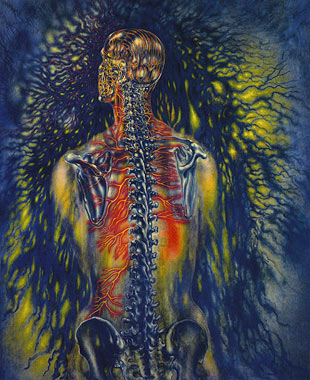 Fig. 3 Column of Fire (Spine), Pavel Feodorovitch Tchelitchev, oil on canvas, c. 1948. Pl. 66, Lincoln Kirstein, Tchelitchev. Witney Museum of American Art, New York, gift of Lincoln Kirstein.
Fig. 3 Column of Fire (Spine), Pavel Feodorovitch Tchelitchev, oil on canvas, c. 1948. Pl. 66, Lincoln Kirstein, Tchelitchev. Witney Museum of American Art, New York, gift of Lincoln Kirstein.
|
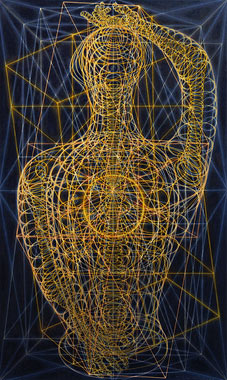 Fig. 4 Vaso D'Oro (golden vessel/vase) , Pavel Feodorovitch Tchelitchev, oil on canvas, c. 1955. Pl. 70, Lincoln Kirstein, Tchelitchev. Lincoln Kirstein, New York.
Fig. 4 Vaso D'Oro (golden vessel/vase) , Pavel Feodorovitch Tchelitchev, oil on canvas, c. 1955. Pl. 70, Lincoln Kirstein, Tchelitchev. Lincoln Kirstein, New York.
|
Figures 1,2,3,4 are all paintings by Tchelitchev. Although Tchelitchev's oeuvre was not limited to these works alone, it is this series that Alex Grey has focused on to create his forgeries with minor modifications. Fig. 4 by Tchelitchev takes on the appearance of a vase. This would symbolically render the body a vessel (vase) which holds the soul which is represented by the circles of energy.
Tchelitchev (Hardcover)
by Lincoln Kirstein (Author) List Price:
$60.00
Product Details
Hardcover: 184 pages
Publisher: Twelvetrees (September 1994)
Language: English
ISBN-10: 0942642406
ISBN-13: 978-0942642407
|
Below, figs. 5,6,7 are the forgeries by Grey. Grey in fig.5 shows the human as a mindless marionette controlled by some psychic energy over which the recipient has no control. Grey has claimed Jungian impulses to guide his ideas. Like others using Jung's theories, the unconscious impulses, it is claimed, lead him to the works of others. These works happen to be images by Tchelitchev, which must have been "uploaded" somehow into the ether. The "original element" in the Grey image, fig. 6, is his inclusion of chakra circles.
As always Jung is the refuge of cranks. As is evident Jung has provided the means for Christian zealots to provide a seemingly secular explanation for the means by which YHWH–cum–Jesus communicates with them and the means by which he communicated with humanity (as written in their holy books) in the past. This is uncannily close in concept to the development by American Creationists of "Intelligent Design" as the means by which Christian fantasy might cloak itself as respectable science, and an alternative to "orthodox" scientific method.
|
A short note on Jung's "archetypes": In 19th century Germany, Plotinus, his Enneads, and like-minded philosophers were very much in favour. The Germans invented the misleading term "neoplatonism" to describe these philosophers. Both Freud and Jung filched Plotinus' ideas on the soul and its divisions, along with the Platonic basis for Plotinus, that an abstraction, IDEA (usually mistranslated as "form" in English), precedes the actual. This IDEA is the "archetype" or "primary form" ascribed to ideas by Jung. The concern of Plotinus was the soul, ψυχή, psyche, hence "psychology" - logic of the soul. A more complete debunking of Freud and Jung lies outside the scope of this essay.
Amazon links: Plotinus' Enneads "Neoplatonism")
|
Below, figs. 5,6,7 are the Grey forgeries.
|
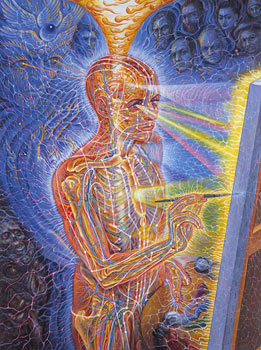 Fig. 5 Painting, Alex Grey, oil, 1998. Metamorphosis, 50 contemporary surreal, fantastic and visionary artists, Johnny Beinart, publisher.
Fig. 5 Painting, Alex Grey, oil, 1998. Metamorphosis, 50 contemporary surreal, fantastic and visionary artists, Johnny Beinart, publisher.
|
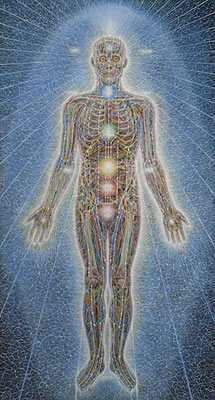 Fig. 6 Psychic Energy System, Alex Grey, oil (?), 1980–81. Illus., p. 36 Raw Vision (magazine), #26, Spring 1999.
Fig. 6 Psychic Energy System, Alex Grey, oil (?), 1980–81. Illus., p. 36 Raw Vision (magazine), #26, Spring 1999.
|
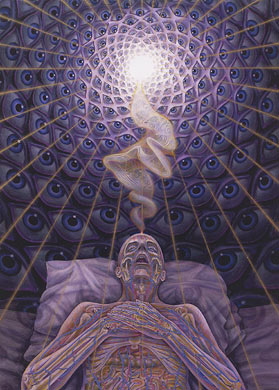 Fig. 7 Dying, Alex Grey, oil, 1990. Metamorphosis, 50 contemporary surreal, fantastic and visionary artists, Johnny Beinart, publisher.
Fig. 7 Dying, Alex Grey, oil, 1990. Metamorphosis, 50 contemporary surreal, fantastic and visionary artists, Johnny Beinart, publisher.
|
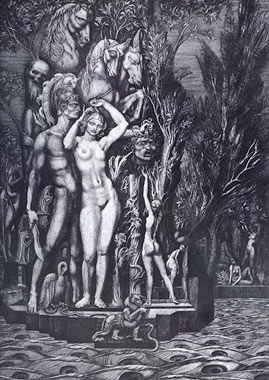 Fig. 8 Venus on the Island of Death, Ernst Fuchs, etching, 1976. P. 36, Ernst Fuchs, Der Feuerfuchs.
Fig. 8 Venus on the Island of Death, Ernst Fuchs, etching, 1976. P. 36, Ernst Fuchs, Der Feuerfuchs.
Grey - without his being consciously aware of it - must have tapped into Jung's ether to acquire elements from this picture kindly "uploaded" into the ether by Fuchs. The eyes that appear in Grey's work, in fig. 7, are taken from Fuchs and they are used to modify his figure taken from Tchelitchev.
|
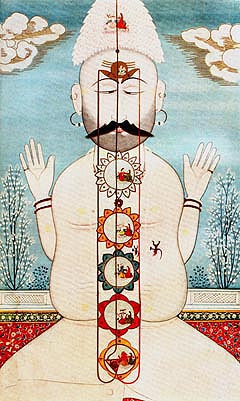 Fig. 9
Fig. 9
http://en.wikipedia.org/wiki/Chakra
Chakra
From Wikipedia, the free encyclopedia (1/12/2008)
"Chakra (derived from the Sanskrit cakra? ∏≥Ëœ¢, Phonetic pronunciation "chukr"…) is a Sanskrit word that translates as wheel or disc. Chakra is a philosophical concept referring to wheel-like vortices which, according to traditional Indian medicine, are believed to exist in the surface of the etheric double of man.[1] The Chakras are said to be "force centers" or whorls of energy permeating, from a point on the physical body, the layers of the subtle bodies in an ever-increasing fan-shaped formation".
|
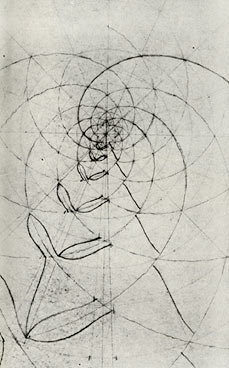 Fig. 10 A logarithmetic spiral network used by Escher to workout some of his spiral designs. These designs seem to have infiltrated new–age pseudo–Hindu designs of the later 20th century which appear to be unattested to in earlier Indian art. Illus. 239, Bruno Ernst The Magic Mirror of M.C. Escher.
Fig. 10 A logarithmetic spiral network used by Escher to workout some of his spiral designs. These designs seem to have infiltrated new–age pseudo–Hindu designs of the later 20th century which appear to be unattested to in earlier Indian art. Illus. 239, Bruno Ernst The Magic Mirror of M.C. Escher.
|
In the past Grey acknowledged some association of his work to that by Tchelitchev. The following are his responses to questions regarding his art:
Alex:" …there were artists who were motivated by surrealist and visionary intentions. Pavel Tchelitchev, for example…Pavel Tchelitchev, who's most famous painting, "Hide and Seek" is in the Museum of Modern Art, and well-known to many psychedelic afficianados. It's a magnificient piece done in 1940-41. He spent the remainder of his career, 1942-56 studying the human anatomy, the subtle anatomy and spiritual networks of energy.My work relates strongly to Tchelitchev. After acid trips, I started having visions of glowing bodies with the acupuncture meridians and points, chakras and auras all inter-relating. I started painting these images and a friend of mine told me that Tchelitchev was doing this kind of thing forty years ago. He was starting to do translucent bodies that I think were influenced by "The Visible Man" or "Visible Woman" seen at the New York World's Fair of 1939. Also, the use of X-rays must have influenced him to envision a translucent body. Tchelitchev sometimes painted a glow around the body, as well. He was well-versed in Pythagoreanism and alchemy and was deeply into the occult.… My work is symbolic and projects ideal archetypes…I think Tchelitchev's career will be reassessed, and accorded more value. At any rate I see him as a forefather to my artwork."
According to Grey he had visions of Tchetitchlev–like images under the influence of narcotics. He then considers "Whether he [Tchelitchev] ever took mescaline, I don't know. He was dead before much acid was available."
From "interview with alex grey" http://users.lycaeum.org/~maverick/grey.htm
To summarise Grey's claim: narcotics tune the mind to receiving transmissions from Jung's ether.
Tchelitchev's works were continually exhibited during the middle part of the last century. They were included in exhibitions in the US such as "Surrealism Then and Now" and their accompanying catalogues: http://www.amazon.com/Surrealism-Then-Joseph-Randall-Shapiro/dp/B000M12DPW . In 1964 there was a major exhibition of the works of Tchelitchev. It too was accompanied with a catalogue which is still available. http://www.amazon.com/Pavel-Tchelitchew-Tchelitchev-Exhibition-Gallery/dp/B0013G9T20 . For some however, the Jungian ether makes more sense as the means by which Grey acquired his "visions". Only those willing to believe and those aided by medication can tune into it. This is a restating of the Christian maxim that demands belief in god without reason or proofs.

As Grey's own star has risen references to Tchelitchev are disappearing. There is now an uncritical Wikipedia entry for Alex Grey (refer screenshot above). There is no mention of Tchelitchev (various spellings, eg "Tchelitchew", and partial spellings, eg "Tchel" returned no results). The Wikipedia entry states that he specialises in "spiritual" and " visionary art"; and more absurdly states that "[Grey] is the Chair of Wisdom University's Sacred Art Department." By means of circular reasoning Grey proves the existence of the ether of Jung and seems to derive his income by helping others acquire such "insights."
In the meantime, Tchelitchev's star has faded into a semi–obscurity. His Wikipedia entry is comprised of only a few sentences (see screenshot below). And, as Tchelitchev's star wanes, disingenuous theories involving Jung and the ether are no longer needed to explain the obvious debt owed by Grey to the work by an artist who seems to have been forgotten.
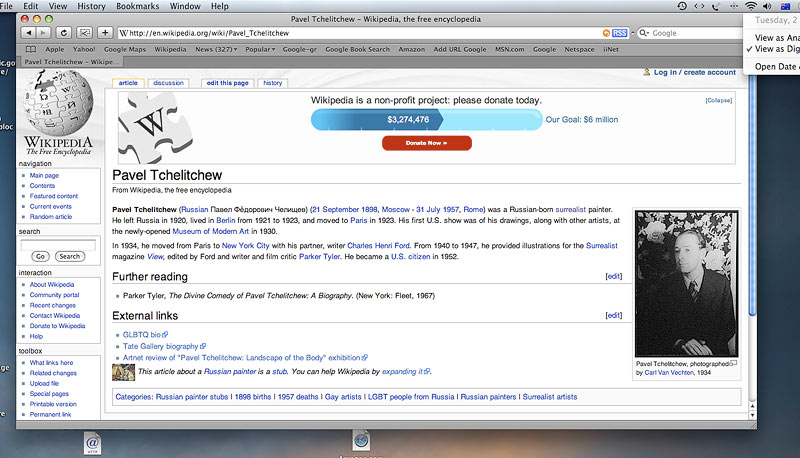
Addenda 10/1202008. De Boeck is not the only promoter of Alex Grey. Damian Michaels too promoted works by him. Below is a photograph of an article from The Courier, newspaper of Ballarat 23/7/2004 showing the Ballarat Gallery director in front of a work by Grey:
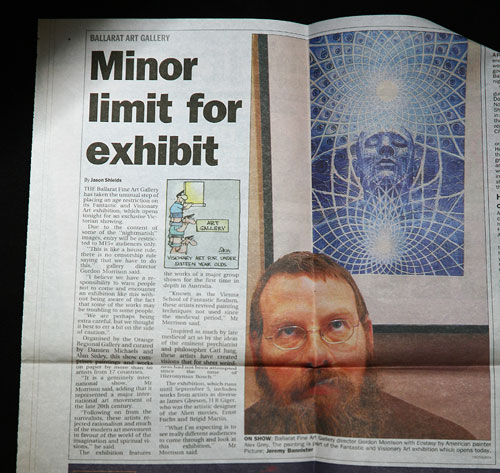
Demetrios Vakras 3/12/2008.
|
graphics and text © demetrios vakras
paintings reproduced here remain the © of the artists (or their estates) and are reproduced here on the principle of fair use.
www.vakras.com
|

